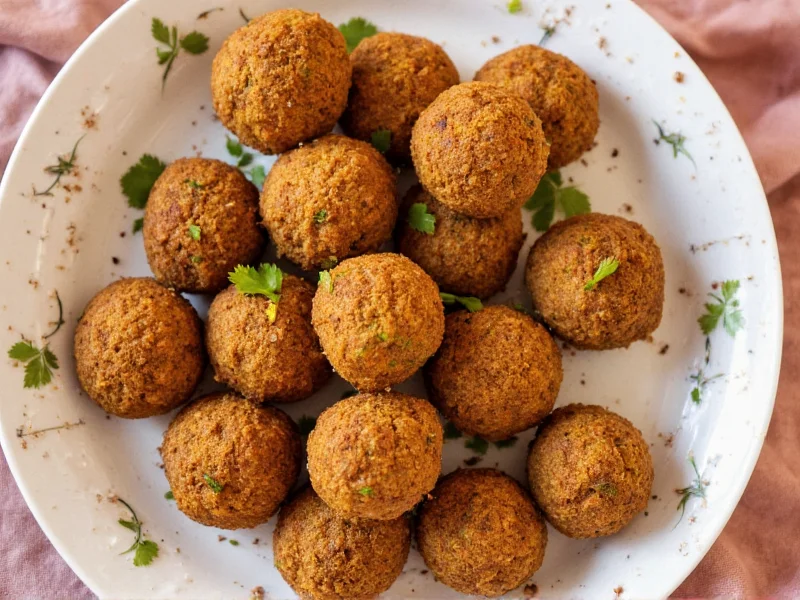The Essential Components of Authentic Falafel Spice
Creating genuinely flavorful falafel requires understanding the precise spice combination that Middle Eastern chefs have perfected over centuries. Unlike generic 'falafel seasoning' found in stores, traditional blends focus on enhancing the natural nuttiness of chickpeas without overpowering them. The foundation consists of three critical elements:
| Spice | Traditional Ratio | Flavor Contribution |
|---|---|---|
| Ground Cumin | 1.5 parts | Earthy warmth, signature base note |
| Ground Coriander | 1 part | Citrusy brightness, balances cumin |
| Fresh Parsley | 0.5 parts (by volume) | Grassy freshness, visual appeal |
| Garlic Powder | 0.25 parts | Subtle pungency without burning |
Why These Specific Spices Work for Falafel
The magic of authentic falafel seasoning lies in how these ingredients interact with soaked chickpeas. Cumin provides the essential earthy backbone that defines Middle Eastern cuisine, while coriander's lemony notes prevent the mixture from becoming muddy. Fresh herbs like parsley and cilantro add moisture and brightness that dried herbs can't replicate. Professional chefs emphasize that garlic should always be used in powder form rather than fresh to avoid burning during deep frying.
Many home cooks make the mistake of adding turmeric or chili powder to their homemade falafel seasoning recipe, but traditional preparations from Egypt and Lebanon rarely include these. The delicate chickpea flavor gets overwhelmed by strong spices. For authentic results, keep the blend simple and focused on the core quartet: cumin, coriander, parsley, and garlic.
Regional Variations Across the Middle East
While the basic falafel herb and spice combination remains consistent, regional differences exist:
- Egyptian falafel (made with fava beans) uses more cumin and often includes a pinch of cayenne
- Lebanese falafel emphasizes fresh cilantro alongside parsley for brighter flavor
- Syrian preparations sometimes add a touch of mint for complexity
- Palestinian versions frequently include a small amount of ground cardamom
Understanding these nuances helps you tailor your traditional falafel spice blend to match specific regional styles. The key is maintaining the 3:2 ratio between cumin and coriander as your foundation, then adjusting secondary elements to preference.
Creating Your Own Falafel Spice Mix
For the best results, make your homemade falafel seasoning recipe fresh whenever possible. Pre-ground spices lose potency quickly. Here's a professional chef's method:
- Toast whole cumin and coriander seeds in a dry skillet over medium heat for 2-3 minutes until fragrant
- Grind the toasted seeds immediately using a spice grinder or mortar and pestle
- Mix with fresh chopped parsley (never dried) and garlic powder
- Use within 24 hours for maximum flavor impact
This approach creates a more vibrant authentic Middle Eastern falafel spices profile than store-bought alternatives. The toasting process unlocks essential oils that dried spice jars can't match. When measuring your falafel spice ratio, remember that volume measurements work better than weight for these light ingredients.
Avoiding Common Falafel Seasoning Mistakes
Even experienced cooks make critical errors with best spices for chickpea falafel. Watch for these pitfalls:
- Using pre-ground spices - Loses 60% of flavor compounds within weeks
- Adding salt to the spice mix - Draw out moisture from chickpeas, causing soggy texture
- Overpowering with garlic - Fresh garlic burns during frying, creating bitter notes
- Ignoring freshness of herbs - Wilted parsley creates muddy flavor instead of bright notes
Professional falafel makers always add salt separately after mixing the spice blend with chickpeas. This preserves texture while allowing precise seasoning control. For optimal results, use your how to make falafel spice mix within one day of preparation.
Storage Guidelines for Maximum Freshness
If you must prepare your traditional falafel spice blend ahead of time, follow these storage protocols:
- Store in an airtight container away from light and heat
- Keep whole seeds rather than ground spices for longer shelf life
- Never store near the stove or oven where temperature fluctuates
- Freeze herb components separately in ice cube trays with olive oil
Ground spices maintain peak flavor for only 3-4 months under ideal conditions, while whole seeds stay fresh for up to a year. For serious enthusiasts, investing in a small spice grinder ensures you can create fresh authentic Middle Eastern falafel spices whenever needed.
Falafel Spice vs. Other Middle Eastern Blends
Many home cooks confuse falafel seasoning vs za'atar, but they serve completely different purposes. Za'atar contains sumac, sesame seeds, and thyme - making it too acidic for falafel batter. Similarly, baharat and ras el hanout blends contain warming spices like cinnamon and cloves that overwhelm delicate chickpea flavor.
The unique challenge of falafel spice ratio is creating depth without heaviness. Unlike meat rubs that need robust flavors to penetrate, falafel spices must enhance rather than dominate the chickpea base. This delicate balance explains why generic 'falafel seasoning' from supermarkets often disappoints compared to authentic preparations.











 浙公网安备
33010002000092号
浙公网安备
33010002000092号 浙B2-20120091-4
浙B2-20120091-4